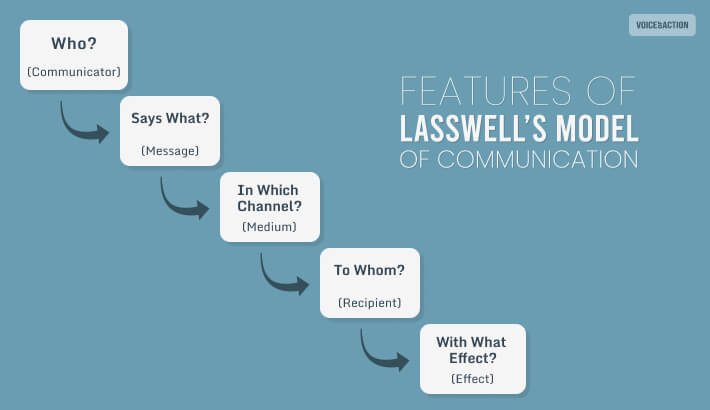5 Key Features Of Lasswell Model Of Communication

Have you ever heard about the Lasswell model of communication? If you haven’t, then it’s fine because we are going to talk at length about the same. But, more importantly, if you have heard about them in the past, then this is your time to brush your knowledge and maybe take some communication pointers that would prove to be helpful later?
So without wasting any time, let’s talk about Lasswell and his model of communication – keep reading, and don’t forget to stick around for an intensive experience.
What Is Lasswell Model Of Communication: Let’s Communicate?
Harold Lasswell’s model of communication is not just the very first, but it also happens to be one of the most influential communication models. Harold Lasswell initially published this communication model sometime in 1948 – the model basically analyzed communication in the context of five crucial questions.
These questions are as follows,
- ‘Who?’
- ‘Says What?’
- ‘To Whom?’
- ‘In What Channel?’
- ‘With What Effect?’
If you have noticed, the five questions mentioned above select the fundamental components from the entire process of communication,
- the sender,
- the channel,
- the message,
- the receiver, and
- the effect.
According to several theorists, the Lasswell model of communication is also known as ‘Lasswell’s definition,’ or ‘Lasswell’s formula,’ or even ‘Lasswell’s construct.’ Moreover, initially, this communication model was simply looked at specifically as a mass communication model well suited for newspapers, television, and radio. But at present, it has evolved into a general communication model.
Today, theorists have further expanded the model and included a few additional questions, such as,
- ‘For What Purpose?’
- ‘Under What Circumstances?’
So, now that you have understood what the Harold Lasswell model of communication is all about let’s talk about its key features!
The Harold Lasswell Model Of Communication: 5 Key Features
The Lasswell model of communication is pretty easy to understand – there are 5 questions on which the entire communication model is dependent. So, today, we will look at all five key features closely. But let’s not beat around the busy and dive straight into the world of Harold’s transmission!
1. Who?
Component: The Communicator or the Sender.
A sender, according to Lasswell, can be a number of people, such as,
- A journalist writing a newspaper column,
- A lecturer at a University,
- A blogger writing a blog, or
- A person on television.
When you are asking ‘who?’ – it basically deals with who is sending the message. Of course, during Lasswell’s time, the number of senders was limited, but today, the number of senders has only increased with the growth of social media. Today, anyone can send information using a number of platforms.
2. Says What?
Component: The Message
The ‘Says What’ part is perhaps the most vital part of this communication model. Most mass communication models are all about what is the message that you are sending out – the content matter of your communication. So, for example, if you are writing a blog, then you are the ‘who,’ and the content you are writing automatically becomes the ‘says what’ part.
Moreover, this is vital because how can you communicate if there’s no purpose or no content? The ‘says what’ deals with what is it that the sender is saying, writing, or even publishing?
3. In Which Channel?
Component: The Medium
The third key feature of the Lasswell model of communication is the medium you are using for sending and even receiving messages. So, for example, if you are writing in a newspaper and communicating with your readers, then, in that case, you are the sender, whatever you are writing is the message, and the newspaper is the medium.
In the modern context, when you are uploading a photo on your Instagram and communicating with your followers, you become the sender, your photo the message, and Instgram, in this case, the medium of communication between you and your followers. Of course, your followers are your receivers.
4. To Whom?
Component: The Audience
The audience, according to Lasswell, comprises mostly receivers relevant to the mass communication industry, such as,
- A nation’s citizens,
- A magazine’s readers,
- Adults for adults products,
- Children for television hours meant for kids, and
- Women for specific products.
Naturally, the scene has changed – you could just follow a famous influencer on a different continent and still be in their audience group. The world has truly become a completely different place with the evolution of the internet. Simply put, when you upload a photo on Facebook, your friends on Facebook are your audience.
5. With What Effect?
Component: Effects
What most models of mass communication don’t tell you is the effect of the message you have just sent. How does the audience feel after receiving the message? For instance, when a journalist reports on the death of a popular celebrity to their readers, the feelings that the readers experience falls under this category.
In the modern context, when your audience responds to your social media content, it showcases how they feel about your content in the first place – what’s the effect that your content basically have on them?
Frequently Asked Questions (FAQs):
Check out the most frequently asked questions related to the Lasswell model of communication mentioned below!
➥ The 8 models of communication are as follows,
• Linear communication model,
• Laswell’s communication model,
• Berlo’s S-M-C-R communication model,
• The Osgood-Schramm communication model,
• Aristotle’s communication model,
• The Shannon-Weaver communication model,
• Interactive communication model, and
• The Westley and Maclean communication model.
➥ The three primary features of Laswell’s model are as follows,
• Surveillance,
• Correlation, and
• Transmission.
➥ The eight dimensions of communication are as follows,
• Organizational Integration,
• Climate,
• Relationship With Superiors,
• Informal Communication,
• Organizational perspective,
• Personal Feedback,
• Media Quality, and
• Relationship With Subordinates.
➥ The 4 characteristics of a linear model of communication are as follows,
• Sender,
• Message,
• Channel, and
• Receiver.
And It’s A Wrap!
You don’t need to use different models of communication examples to understand how the Lasswell model of communication actually functions or what it even indicates. We found it pretty simple – a sender uses a channel to send a message to the receiver, and the receiver receives the same effect.
Naturally, the entire process is summed up by Lasswell in his communication model. So tell us what you think. And while doing so, share your experiences or even communication hurdles in the comments below.
Read More:


























